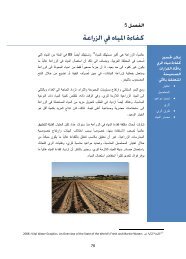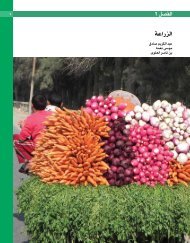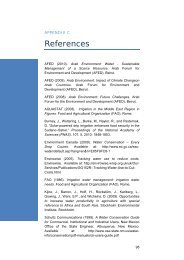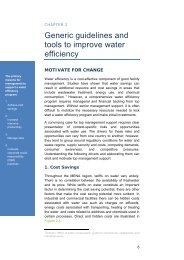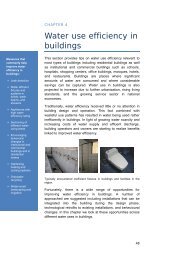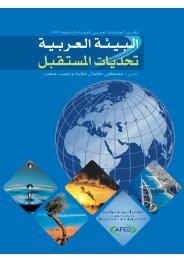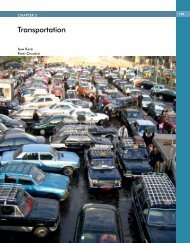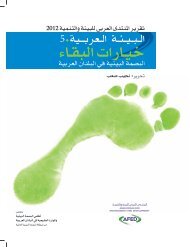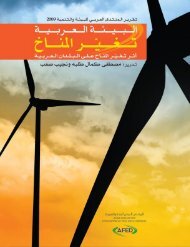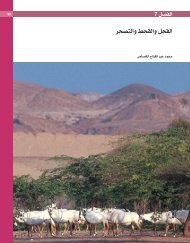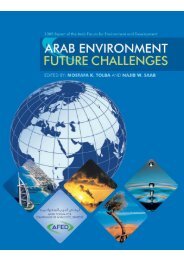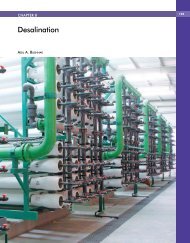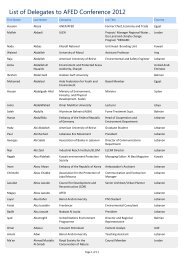Impact of Climate Change on Arab Countries - (IPCC) - Working ...
Impact of Climate Change on Arab Countries - (IPCC) - Working ...
Impact of Climate Change on Arab Countries - (IPCC) - Working ...
Create successful ePaper yourself
Turn your PDF publications into a flip-book with our unique Google optimized e-Paper software.
80<br />
CHAPTER 6<br />
FRESH WATER<br />
ences <strong>on</strong> the envir<strong>on</strong>ment, climate, ec<strong>on</strong>omy and<br />
culture <str<strong>on</strong>g>of</str<strong>on</strong>g> the coastal areas providing them with an<br />
important source <str<strong>on</strong>g>of</str<strong>on</strong>g> moisture and a heat reservoir.<br />
The situati<strong>on</strong> in the Mediterranean regi<strong>on</strong> is very<br />
complex due to large differences between different<br />
areas. While at its northwest coast populati<strong>on</strong><br />
growth has practically stopped, a two-fold<br />
increase is expected in North African countries<br />
during the first three decades <str<strong>on</strong>g>of</str<strong>on</strong>g> the 21 st century,<br />
with an even larger growth taking place in Syria<br />
and Palestine, adding more stress to the already<br />
scarce water resources. Global projecti<strong>on</strong>s present<br />
remarkable agreement <strong>on</strong> the Mediterranean<br />
regi<strong>on</strong>, where warming is expected to be larger<br />
than the global average with a large percent<br />
reducti<strong>on</strong> in precipitati<strong>on</strong> and an increase in<br />
inter-annual variability (Giorgi, 2006).<br />
Global simulati<strong>on</strong> can not be c<strong>on</strong>sidered accurate<br />
for the descripti<strong>on</strong> <str<strong>on</strong>g>of</str<strong>on</strong>g> the Mediterranean regi<strong>on</strong><br />
and downscaling by statistical methods and<br />
dynamic models can, in some situati<strong>on</strong>s, be used<br />
to provide better insight and give results with<br />
higher precisi<strong>on</strong>. Development <str<strong>on</strong>g>of</str<strong>on</strong>g> a regi<strong>on</strong>al<br />
model simulati<strong>on</strong> for the Mediterranean is<br />
presently missing and <strong>on</strong>e needs to be made in<br />
the future. Moreover, room should be left for different<br />
approaches such as statistical downscaling<br />
and other techniques.<br />
Leban<strong>on</strong>, taken as <strong>on</strong>e <str<strong>on</strong>g>of</str<strong>on</strong>g> the advanced countries<br />
with respect to climate change research, displays<br />
the following vulnerability issues (Assaf, 2009):<br />
• Chaotic urbanizati<strong>on</strong> at the expense <str<strong>on</strong>g>of</str<strong>on</strong>g> forests<br />
and wood lands.<br />
• Air, water and soil polluti<strong>on</strong>.<br />
• Increasing frequency <str<strong>on</strong>g>of</str<strong>on</strong>g> fires due to prol<strong>on</strong>ged<br />
dry seas<strong>on</strong>s.<br />
• <str<strong>on</strong>g>Change</str<strong>on</strong>g> <str<strong>on</strong>g>of</str<strong>on</strong>g> water table level due to excessive<br />
pumping and quarrying activities.<br />
• Overgrazing <str<strong>on</strong>g>of</str<strong>on</strong>g> rangelands.<br />
• Land fragmentati<strong>on</strong>.<br />
Morocco is another example <str<strong>on</strong>g>of</str<strong>on</strong>g> an <strong>Arab</strong><br />
Mediterranean country in which climate change<br />
research is well advanced. The country has prepared<br />
its First Nati<strong>on</strong>al Communicati<strong>on</strong> to the<br />
UNFCCC, and is in the process <str<strong>on</strong>g>of</str<strong>on</strong>g> developing<br />
the Sec<strong>on</strong>d Nati<strong>on</strong>al Communicati<strong>on</strong> Report.<br />
A map <str<strong>on</strong>g>of</str<strong>on</strong>g> composite indicators representing the<br />
vulnerability <str<strong>on</strong>g>of</str<strong>on</strong>g> both agriculture and domestic<br />
water uses to climate stress in the form <str<strong>on</strong>g>of</str<strong>on</strong>g> l<strong>on</strong>g<br />
hot and dry spells was generated to identify areas<br />
<str<strong>on</strong>g>of</str<strong>on</strong>g> high vulnerability. The results indicated that<br />
the ecosystem <str<strong>on</strong>g>of</str<strong>on</strong>g> the Tensift River Basin is very<br />
vulnerable with various degrees <str<strong>on</strong>g>of</str<strong>on</strong>g> vulnerability<br />
in different parts <str<strong>on</strong>g>of</str<strong>on</strong>g> the regi<strong>on</strong>.<br />
Libya has a prevailing Mediterranean climate<br />
and a geography characterized by coastal valleys<br />
and heights; rainy cold winters and dry hot summers;<br />
as well as the seas<strong>on</strong>s <str<strong>on</strong>g>of</str<strong>on</strong>g> spring and<br />
autumn in which the khamasin winds – locally<br />
called Gebli winds – blow. The country has ratified<br />
a number <str<strong>on</strong>g>of</str<strong>on</strong>g> United Nati<strong>on</strong>s agreements<br />
and protocols and is treated as <strong>on</strong>e <str<strong>on</strong>g>of</str<strong>on</strong>g> the Less<br />
Developed <strong>Countries</strong> in its mitigati<strong>on</strong> and<br />
adaptati<strong>on</strong> measures to climate change. Water<br />
resources in Libya are limited to rainfall in the<br />
north and modest quantities <str<strong>on</strong>g>of</str<strong>on</strong>g> groundwater in<br />
the south. C<strong>on</strong>tinued abstracti<strong>on</strong> <str<strong>on</strong>g>of</str<strong>on</strong>g> fossil<br />
groundwater will bring the country’s aquifers to<br />
a state <str<strong>on</strong>g>of</str<strong>on</strong>g> low feasibility by 2050.<br />
If the intensity <str<strong>on</strong>g>of</str<strong>on</strong>g> rainfall is reduced, as predicted<br />
by many sources, then the country will have<br />
no other opti<strong>on</strong> but to depend heavily <strong>on</strong> desalinati<strong>on</strong><br />
or to import surface water from neighbouring<br />
countries. Both alternatives are fairly<br />
costly especially as the country suffers a populati<strong>on</strong><br />
growth rate which ranges between 2.5 and<br />
3%.<br />
Syria is vulnerable to climate change because <str<strong>on</strong>g>of</str<strong>on</strong>g><br />
the following reas<strong>on</strong>s:<br />
• More than 75% <str<strong>on</strong>g>of</str<strong>on</strong>g> the cropped area is dependant<br />
<strong>on</strong> rainfall as the main source <str<strong>on</strong>g>of</str<strong>on</strong>g> water.<br />
Therefore, fluctuati<strong>on</strong> in rainfall affects rainfed<br />
agriculture.<br />
• Fluctuati<strong>on</strong> <str<strong>on</strong>g>of</str<strong>on</strong>g> temperature affects crop yields.<br />
• Increased frequency and durati<strong>on</strong> <str<strong>on</strong>g>of</str<strong>on</strong>g> droughts<br />
affect crop producti<strong>on</strong> and food availability.<br />
In Egypt, rain-fed agriculture is limited to the<br />
north coast and is extended over a distance <str<strong>on</strong>g>of</str<strong>on</strong>g><br />
1200 km where modest precipitati<strong>on</strong> <str<strong>on</strong>g>of</str<strong>on</strong>g> 100 –<br />
200 mm intensity falls every year, in particular<br />
during the winter m<strong>on</strong>ths (December -<br />
February). If this already limited amount <str<strong>on</strong>g>of</str<strong>on</strong>g> rain<br />
is reduced further, life in these regi<strong>on</strong>s will<br />
become intolerable unless Nile water is c<strong>on</strong>veyed<br />
from the east and west branches <str<strong>on</strong>g>of</str<strong>on</strong>g> the<br />
Damietta and Rosetta branches <str<strong>on</strong>g>of</str<strong>on</strong>g> the Nile.



